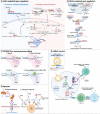RNA-based therapeutics: an overview and prospectus
- PMID: 35871216
- PMCID: PMC9308039
- DOI: 10.1038/s41419-022-05075-2
RNA-based therapeutics: an overview and prospectus
Abstract
The growing understanding of RNA functions and their crucial roles in diseases promotes the application of various RNAs to selectively function on hitherto "undruggable" proteins, transcripts and genes, thus potentially broadening the therapeutic targets. Several RNA-based medications have been approved for clinical use, while others are still under investigation or preclinical trials. Various techniques have been explored to promote RNA intracellular trafficking and metabolic stability, despite significant challenges in developing RNA-based therapeutics. In this review, the mechanisms of action, challenges, solutions, and clinical application of RNA-based therapeutics have been comprehensively summarized.
© 2022. The Author(s).
Conflict of interest statement
The authors declare no competing interests.
Figures



References
Publication types
MeSH terms
Substances
LinkOut - more resources
Full Text Sources
Other Literature Sources

